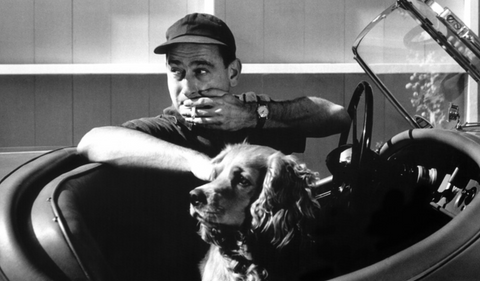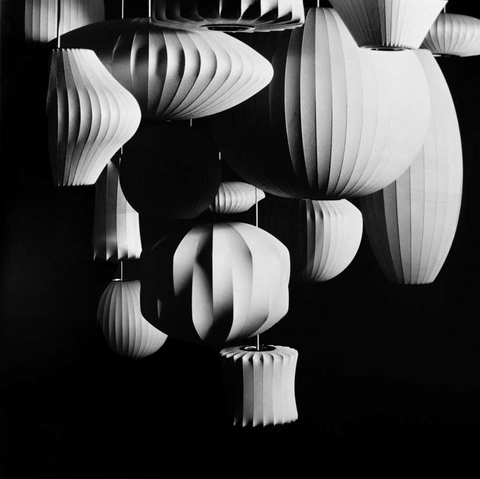Only 1 left
Schedule a video call to learn more about this piece
619-300-3551
A rosewood thin edge chest designed by George Nelson for Herman Miller with exquisite rosewood grain and early original white porcelain handles.
Dimensions: 33.75 L x 18.5 D x 30.5 H
About the Designer:
George Nelson: The Man Behind American Modernism
Not everyone thinks of George Nelson when they think “Modernism”—but they should. Here’s why:

Looking at the outset of George Nelson’s career, few would have guessed that his legacy would crown him as one of the most influential individuals in Modernism—story has it that the young Ivy Leaguer stumbled into the Yale School of Architecture seeking shelter from the rain, and only then did he consider studying design. His legacy, though, would be one that touched nearly every corner of American Modernism as we think of it today.
As an architect, author, furniture designer, graphic designer, exhibition designer, teacher, amateur photographer, and general provocateur, George Nelson shaped the course of design in America for over four decades.
After completing his two Bachelor’s degrees (one in architecture, the other in fine arts), Nelson went on to accept a traveling fellowship in Rome, which interfaced him with figures like Ludwig Mies Van Der Rohe, Walter Gropius, Le Corbusier, and Gio Ponti all of which he interviewed for Pencil Point, bringing the European vanguard to the attention of the magazine’s American readership.
At this point in his career, Nelson had devoted himself to writing, joining Architectural Forum as its first associate editor in 1935. For nearly a decade, Nelson’s post as an editor brought him face-to-face with many of the leaders of the Modernism movement in the U.S., and through these exchanges, his own stance in the design world began to solidify. For Nelson, the purpose of design was to improve the world in accordance with the laws of nature—and while he hadn’t yet done much designing himself, he was busy teasing out the theoretical details of architecture. In 1940, Nelson co-authored Tomorrow’s House with Henry Wright, and the book went on to be a great commercial success, introducing concepts like the “family room,” and more broadly assuming a solutions-based perspective for architectural design.
It wasn’t long before the book earned him the favorable attention of D.J. Depree, the chairman of Herman Miller the American furniture manufacture. Despite Nelson’s inexperience in furniture design, Depree saw potential in the writer’s approach to the industry: solutions-oriented design with a practical lean. Nelson became the company’s Director of Design in 1947, under the condition that he be allowed to continue his work outside of the company.
From 1947 to 1972, Nelson oversaw the design department at Herman Miller, bringing in the icons that would shape some of the most memorable pieces of mid-century design, from such people as Ray and Charles Eames and Harry Bertoia to Richard Schultz, Donald Knorr, and Isamu Noguchi.
Beginning in the mid-1950s, Nelson’s own design firm began its work in earnest, producing furniture and pioneering a ubiquitous incorporation of design, bringing that same consideration for pragmatism and aesthetics to advertising and marketing materials, image management, and graphic programs. His own firm incorporated in 1955, tapping many of the same designers from the Herman Miller roster for collaborations under George Nelson Associates, Inc.
It was during this period of Nelson’s life and career that many of his most iconic designs came onto the scene—many will be instantly familiar furniture silhouettes that perhaps you didn’t know sprung from George Nelson himself.

Designed by William Renwick of Nelson’s studio, the Bubble Lamp innovatively married an industrial ethos with top-notch aestheticism. Constructed from a steel wire frame, each lamp is then enveloped by a semi-translucent plastic spray that serves as the “shade.” The result: a lantern-like light whose soft glow radiates Modernism, able to shapeshift into several different forms to suit a variety of design schemes.
Designing his first collection in 1945 and appointed design director in 1947, Nelson quickly expanded his purview and transformed the company. Confirming De Pree’s early assessment of Nelson as someone “thinking well ahead of the parade,” he redesigned everything from Herman Miller’s product line to its graphics and marketing and advertising materials. Over the course of his long association with Herman Miller, Nelson designed hundreds of pieces of furniture and recruited other designers, including Charles and Ray Eames, Alexander Girard, and Isamu Noguchi, now all widely acknowledged as some of the brightest talents of the time.
Nelson developed his own designs—from furniture to architecture, and exhibitions to graphics—in his New York City studio, known variously over the years as George Nelson, George Nelson & Associates, and George Nelson and Company. The staff included significant designers in their own right such as Irving Harper, George Mulhauser, Ernest Farmer, Gordon Chadwick, George Tscherny, and Don Ervin; many working for the office for years. Others, such as Michael Graves, Ettore Sottsass, and Arthur Drexler, worked for just a short time before establishing successful careers of their own; in Drexler’s case not as a designer but as the long-standing and influential Director of the Department of Architecture and Design at the Museum of Modern Art in New York. Clients of the Nelson office included Olivetti, General Electric, Rosenthal and Aluminum Extrusions. In 1959 Nelson was the lead designer for the American National Exhibition in Moscow, which, at its July 24 opening, was the site for a series of impromptu exchanges between then Vice President Richard M. Nixon and Soviet Premier Nikita Khrushchev, the subject of a media frenzy that became popularly known as the “Kitchen Debate.”
All in all, Nelson’s career spanned until the mid-1980s, when he closed his eponymous design studio to signal his retirement from the design industry, but he will be remembered for generations to come for the role he played in American Modernism, championing those principles in his leadership at Herman Miller, and in his own design practice as well. Nelson may not have been the eminent designer of the mid-century era, but as a connector of people and ideas, his influence was singular and lasting.